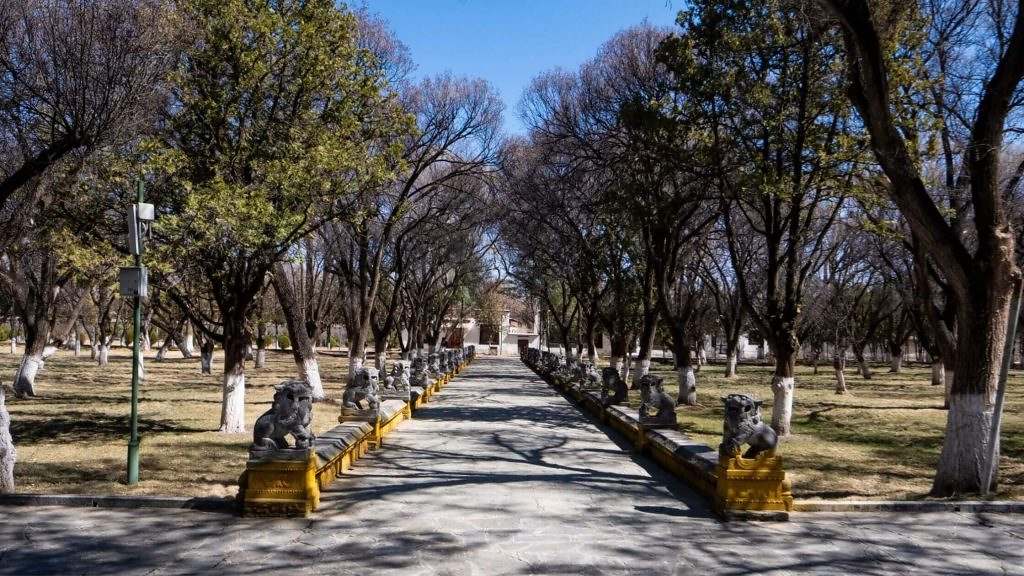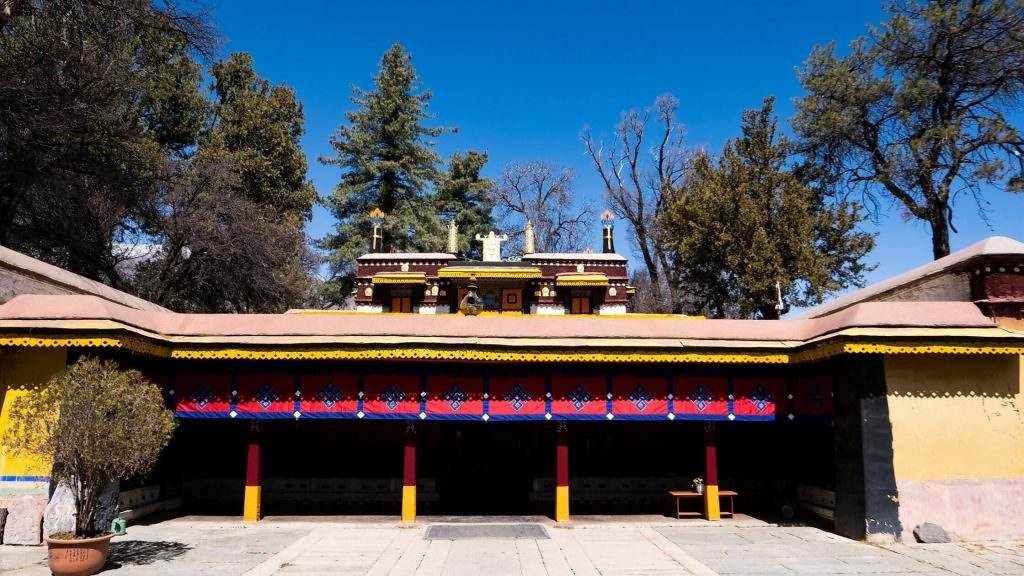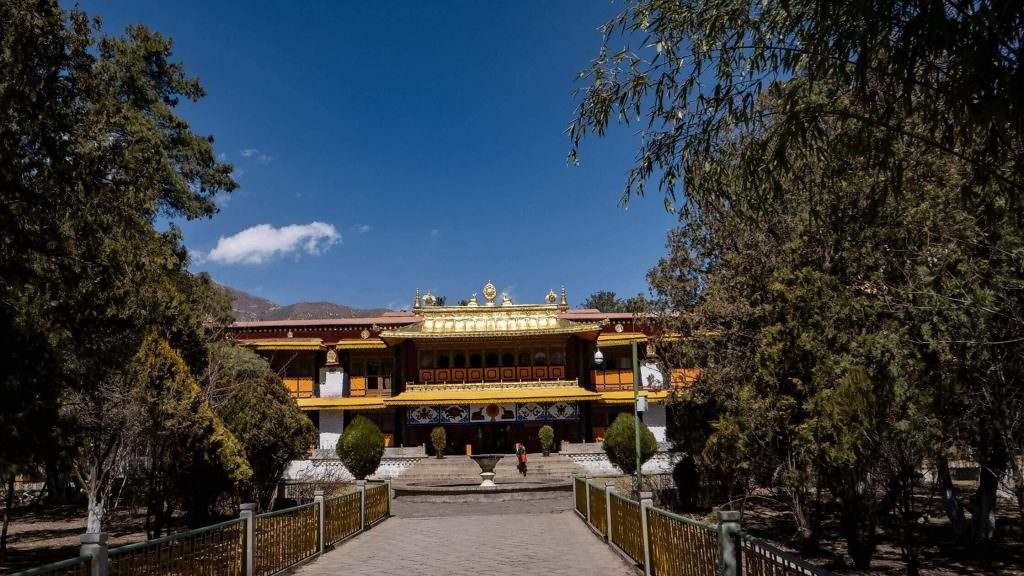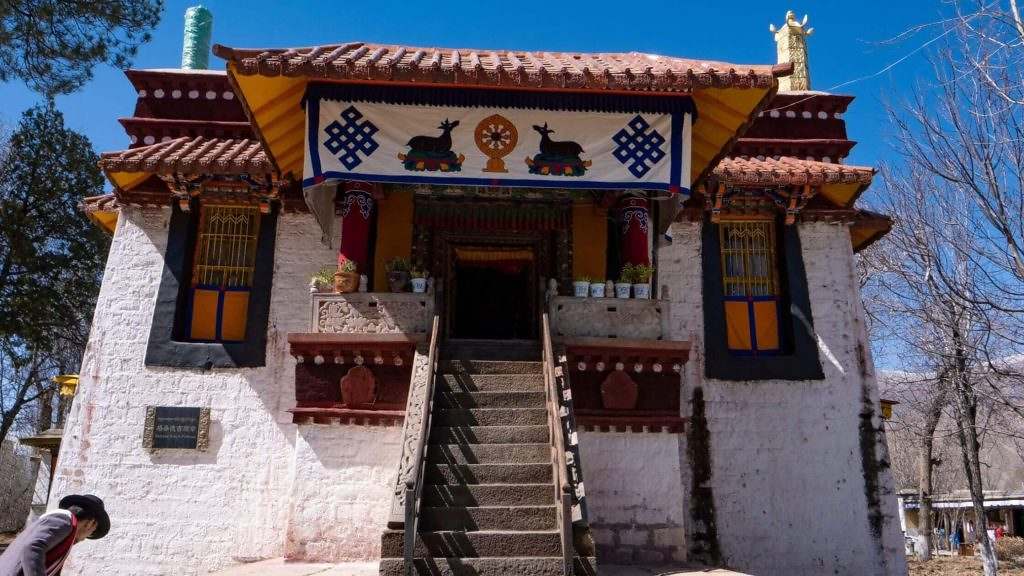This 40-hectare park is entered from the main gate on Mirik lam, south of the Lhasa Hotel and the Nepalese Consulate. The site was developed as the Summer Palace of the Dalai Lamas, in the mid-18th century, when Dalai Lama VII selected it on account of a medicinal spring where he would bathe owing to his frail disposition. Thus, the initial Uyab Podrang was built, and its site was subsequently augmented in 1755 by the construction of the Kelsang Podrang.

Later, the complex became known as the Summer Palace because the Tibetan government would move here from the Potala Palace on the 18th day of the third lunar month. Dalai Lama VIll (1758-1804) expanded the complex, building the debating courtyard (Choera), the Tsokyil Podrang (marking the location of the original medicinal spring), the Lukhang Lho Pavilion, the Druzing Podrang, and the adjacent southeast perimeter wall.
Dalai Lama XIII (1876-1933) later upgraded the gardens of the Kelsang and Chensel palaces, developed the Tsokyil Podrang area, and finally in 1930 oversaw the construction of the Chensel Lingka in the northwest area of the park.
This new complex itself contains three palaces. Chensel Podrang, Kelsang Dekyil Podrang, and Chime Tsokyil Podrang. Finally, Dalai Lama XIV constructed the new palace or Takten Migyur Podrang between 1954-56.
Norbulingka is divided into three areas: the palaces, the opera grounds, and the government buildings, among which the opera grounds comprise the open-air stage and gardens to the east of the complex, adjacent to the entrance, where operatic performances are held during the Yoghurt Festival.
Further north and to the west of the Takten Migyur Podrang are the government offices and Lonyenkhang (the former cinema), now occupied by the park attendants and the Cultural Office of Tibet. The actual palace section comprises four integral complexes which are visited by the pilgrim in the following sequence: Kelsang Podrang (southeast), Taken Migyur Podrang (north), Tsokyil Podrang (C), and Chensel Podrang (northwest).

This three-story palace is named after Dalai Lama VII, Kelzang Gyatso, who commissioned its construction in 1755. The central feature of the complex is the north-facing reception hall known as Tshomchen Nyiwo, entered via a south-facing cloister, which permits bright sunlight to enter the chamber through its large skylight.
The centerpiece is the Dalai Lama’s throne, backed by images of Shakyamuni, the Eight Medicine Buddhas, and the Sixteen Elders. Murals depict the Lords of the Three Enlightened Families, and the Three Ancestral Religious Kings, and there are also 100 applique tangkas depicting the Three Deities of Longevity.
There are two libraries (northwest and northeast); and the private apartments of the Dalai Lamas. The latter include the study room known as Tosam Gokyil (Southeast), which has murals depicting Shakyamuni, Tsongkhapa’s five visions, and Manjushri riding a snow lion; the Reception Hall with its life-size images of Buddha and Kalachakra, and murals depicting the life of Dali Lama XIII and his retinue; and the Cultural Hall (Rik-ne Khang), which functions as a library and has murals depicting Avolokiteshwara, Tsongkhapa’s five visions, and the symbol of elemental power and buddha attributes (Namchu Wangden).
The single-story east-facing Uyab Lhakhang is the oldest building in Norbulingka. It is located west of the Kelsang Podrang and was used as a meditation chamber by the Dalai Lamas. Note the simpler construction. The central room contains a golden throne and image of Shakyamuni Buddha, with murals depicting the Three Ancestral Religious Kings, the Sixteen Elders, the Potala Palace, the Jokhang Temple, Reting Monastery, and Norbulingka Palace. There is also a small study library (Chakpe Khang) and a meditation room (Nyendzok Khang).
The two-story Khamsum Zilnon Pavilion is located 70 meters northeast of the Kelsang Podrang and was built into the grounds of the palace. It was formerly used as an observation point for the Dalai Lamas and their entourage during the Yoghurt Festival. Originally constructed by Dalai Lama XIII, it was replaced with a more elaborate structure by the Reting regent during the present century. The chambers of the Dalai Lamas, their tutors, and officials are on the second floor.

Takten Migyur Rodrang is an elaborate two-store building, located north of the Tsokyil Podrang. The roof is surmounted by its wheel and deer emblem, and the south-facing façade has large glass windows.
Ground Floor Tiger-skin maces symbolizing royal dominion flank the entrance. The Shomchen Nelenkhang in the southeast is a European-style reception room distinguished by a gold image of Manjushri flanked by gilder copper images of the Eight Medicine Buddhas.
Second Floor the South Assembly Hall (Shomchen Lhoma Sichi Dogukyil) has two entrances on the west side, while the south wall is composed of floor-to-ceiling windows.
The north wall has images of Shakyamuni Buddha flanked by Manjushri and Maitreya, surmounted by a wall-length embroidered frieze depicting the great Indian Buddhist commentators. On the east wall, there is an applique tangka of Yamantaka, suspended above the splendid throne of the Dalai Lama. The celebrated murals of the west, north, and east walls depict 301 scenes from Tibetan civilization – commencing with its legendary origins and continuing down to the period of Dalai Lama XIV.
The Zimchung Drodren Semchok-Khang is the name given to the Dalai Lama’s private quarters, comprising an anteroom and an inner chamber. The former has an embroidered sofa, above which is an ornate silk applique depicting Atisha, Ngok Lekpei Sherab, and Dromtonpa, surmounted by the Sadampa protector deities.

The 18th-century recreational complex of Tsokyil Podrang comprises three islands on an artificial lake. Among these, the central island accommodates the Lhundrub Gyatsel Tsokyil Podrang, the site of the original medicinal spring used by Dalai Lama VII. The palace was built in Chinese style with a pagoda roof in 1784 by the regent Demo Qutugtu Delek Gyatso. A boating lake was subsequently added in 1887 by the young Dalai Lama XIlI, and, at the same time, animals were first introduced to Norbulingka Zoo.
The Lukhang Nub pavilion was constructed on the north island, also in 1784. Its pagoda roof is supported by several Tibetan-style architectural features including an architrave of lotus twigs. The shrine is dedicated to Nagaraja, its murals depicting Ling Gesar, and the legendary competition of magical prowess held between Milarepa and the Bonpos at Mount Kailash.

The Lukhang Shar pavilion, east of the lake, houses ritual implements. West of the lake is the two-story Druzing Podrang, also known as Dekyi Kunga Kyilwei Podrang, which was built by Dalai Lama XIII as a library and retreat. Pebbles deposited as a cairn by him are still visible outside the entrance. The building was renovated in 1982.
